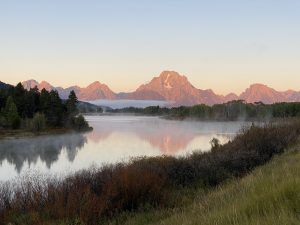 We thought that Grand Teton was going to be a quick side trip from Yellowstone but we stayed a bit longer than foreseen. To be honest we really did not know too well what to expect. In this region it’s usually the big brother,Yellowstone, that gets all the attention. But we did know one thing; this park was going to be our last realistic chance to see moose on this trip. And it was now end of September so the bulls would finally have their famous big antlers. Male moose lose their antlers every spring but they grow back by fall, just in time to be used in the mating season clashes with other bulls. The weeks before getting to Grand Teton we had been on the look out but without success. As we were about to leave ‘moose habitat’ it was ‘now or never’.
We thought that Grand Teton was going to be a quick side trip from Yellowstone but we stayed a bit longer than foreseen. To be honest we really did not know too well what to expect. In this region it’s usually the big brother,Yellowstone, that gets all the attention. But we did know one thing; this park was going to be our last realistic chance to see moose on this trip. And it was now end of September so the bulls would finally have their famous big antlers. Male moose lose their antlers every spring but they grow back by fall, just in time to be used in the mating season clashes with other bulls. The weeks before getting to Grand Teton we had been on the look out but without success. As we were about to leave ‘moose habitat’ it was ‘now or never’.
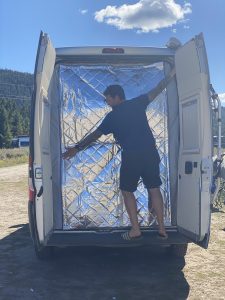 The first thing we noticed when we arrived in the park, was that Autumn had definitely arrived. We were still swimming in lakes in Washington, 10 days earlier, but here (due to the high elevation and micro climate) the leaves were already falling and it was freezing at night. It was time to give our van a winter make-over (install the extra isolation) and get some of the winter clothes out of the trunk.
The first thing we noticed when we arrived in the park, was that Autumn had definitely arrived. We were still swimming in lakes in Washington, 10 days earlier, but here (due to the high elevation and micro climate) the leaves were already falling and it was freezing at night. It was time to give our van a winter make-over (install the extra isolation) and get some of the winter clothes out of the trunk.
The second thing we noticed, were the amazing landscapes of the park. Tectonic movement pushed up a wall of sharp mountains while next to it huge flatlands sunk down. Hard to describe but the views were really spectacular.
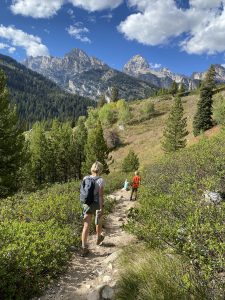 But we had a clear goal here: find a bull moose. Our first attempts were not so successful. Even though we got up before sunrise and went to the places that they usually frequent, there were no moose to found. We did see a lot of elk, a grizzly and the most amazing sunrises.
But we had a clear goal here: find a bull moose. Our first attempts were not so successful. Even though we got up before sunrise and went to the places that they usually frequent, there were no moose to found. We did see a lot of elk, a grizzly and the most amazing sunrises.
During the day, the moose are usually hidden in the woods so we did some smaller hikes at the foot of the mountains. With the arrival of autumn and cold weather, also came the traditional coughs and colds, so we had to take it a bit slower with the hikes. But luckily there are plenty of nice short hikes around Grand Teton.
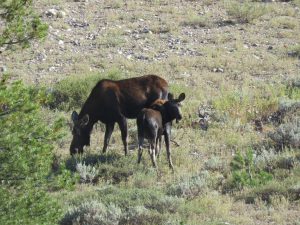 In the late afternoon, on the way to our ‘forest camp’ we wanted to check out another spot where moose often come in the evening. And sure enough, when we got there, we saw some local guides peering through binoculars with their clients. In the distance, there was our first moose of the day, a ‘cow’ with a calf. Really nice but we were still hoping a bull would come out. We started talking to some locals, that were having their Friday evening drinks while spotting wildlife and they shared some ‘secrets’ with us. Bulls did not visit this part of the park often. But they gave us the coordinates for a place by a river where they did show up regularly. And off we went!
In the late afternoon, on the way to our ‘forest camp’ we wanted to check out another spot where moose often come in the evening. And sure enough, when we got there, we saw some local guides peering through binoculars with their clients. In the distance, there was our first moose of the day, a ‘cow’ with a calf. Really nice but we were still hoping a bull would come out. We started talking to some locals, that were having their Friday evening drinks while spotting wildlife and they shared some ‘secrets’ with us. Bulls did not visit this part of the park often. But they gave us the coordinates for a place by a river where they did show up regularly. And off we went!
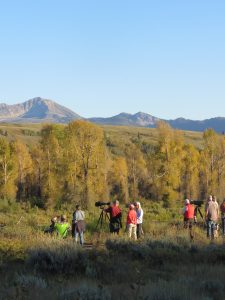 When we got to the spot, there was quite some people there but we immediately noticed that this was a different crowd of ‘wildlife spotters’. No more tourists with Iphones or small cameras (like us) but professionals (or very dedicated amateurs) with big scopes and huge lenses, most of them dressed in ‘camo/hunter’ clothing. We had heard that some of these people can be rather ‘territorial’ and that they are not very willing to share info with the ‘tourists’. But Caro, charming as always managed to make friends with a couple of them quite quickly. And so we found out that a bull had been there 3 hrs earlier but had gone off into the bushes and was not seen after that. From our earlier experiences in Alaska, we knew that these huge animals can just walk into a small bush and disappear like a ghost. He could still be there and appear any second but he might as well be miles away. We decided to stick around. Hallelujah for ‘van life’ because while Caro was on the look out, we could do school work, relax, cook & eat dinner. We learned a lot about the ‘wildlife spotter/photographer’ life style and were impressed by the levels of dedication of these people. Not only are they spending fortunes on all the gear but they also spend all their free time and holidays in one or two parks only looking/waiting for animals. With much pride, they showed us some amazing pictures that they had taken. Often this was a shot that had been taken years ago but it still provided them with happiness & pride today.
When we got to the spot, there was quite some people there but we immediately noticed that this was a different crowd of ‘wildlife spotters’. No more tourists with Iphones or small cameras (like us) but professionals (or very dedicated amateurs) with big scopes and huge lenses, most of them dressed in ‘camo/hunter’ clothing. We had heard that some of these people can be rather ‘territorial’ and that they are not very willing to share info with the ‘tourists’. But Caro, charming as always managed to make friends with a couple of them quite quickly. And so we found out that a bull had been there 3 hrs earlier but had gone off into the bushes and was not seen after that. From our earlier experiences in Alaska, we knew that these huge animals can just walk into a small bush and disappear like a ghost. He could still be there and appear any second but he might as well be miles away. We decided to stick around. Hallelujah for ‘van life’ because while Caro was on the look out, we could do school work, relax, cook & eat dinner. We learned a lot about the ‘wildlife spotter/photographer’ life style and were impressed by the levels of dedication of these people. Not only are they spending fortunes on all the gear but they also spend all their free time and holidays in one or two parks only looking/waiting for animals. With much pride, they showed us some amazing pictures that they had taken. Often this was a shot that had been taken years ago but it still provided them with happiness & pride today.
After another 2 hrs and no sign of a moose (we did see a nice Kingfisher!), we saw that most of the spotters were packing up. The sun was setting and the light conditions were no longer optimal for their ‘one in a lifetime’ shot. Since we still had a bit of a drive to our forest camp, we also decided to leave. A bit sad that we did not get to see ‘our bull’, but decided to come back the next day.
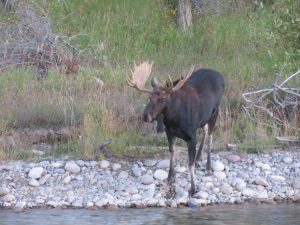 We must have been driving for no more than 5 minutes when we noticed the lights of a line of cars. We quickly parked the van and jumped out to see what was going on…You probably guessed it: we found our bull. It was strolling just across the river and he was magnificent. The antlers were fully grown and huge. Seemingly effortlessly cutting his way through the thick bushes, he looked incredibly powerful.
We must have been driving for no more than 5 minutes when we noticed the lights of a line of cars. We quickly parked the van and jumped out to see what was going on…You probably guessed it: we found our bull. It was strolling just across the river and he was magnificent. The antlers were fully grown and huge. Seemingly effortlessly cutting his way through the thick bushes, he looked incredibly powerful.
The effect of the full grown antlers really can not be underestimated. We had seen a couple of bulls earlier, but without the full antlers they never looked as impressive as the image of a bull moose that we had in mind.
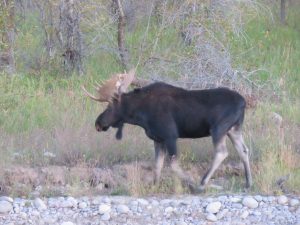 It was truly a magical moment but it was now getting really dark, so we started walking back to the van. But just before we wanted to leave there was another surprise. All of a sudden, a moose cow came out of a little bush right next to the bull. She had been in this bush, that was hardly big enough to conceal such a big animal, all of the time but nobody had noticed her. We could only conclude once more that these animals are really the ‘ghosts’ of the North!
It was truly a magical moment but it was now getting really dark, so we started walking back to the van. But just before we wanted to leave there was another surprise. All of a sudden, a moose cow came out of a little bush right next to the bull. She had been in this bush, that was hardly big enough to conceal such a big animal, all of the time but nobody had noticed her. We could only conclude once more that these animals are really the ‘ghosts’ of the North!
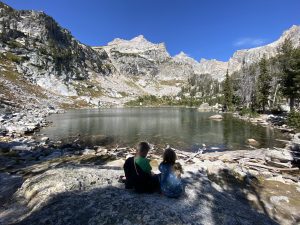 Mission ‘Moose Bull’ accomplished but we stayed a couple of days longer in the park, getting up early to see the amazing sunrises from different places. We also went on what we thought was going to be our last real alpine hike in the USA. It was end of September and winter was just around the corner in this area and that also meant the closure of the high trails (a week later the first snow storm effectively closed the trail).
Mission ‘Moose Bull’ accomplished but we stayed a couple of days longer in the park, getting up early to see the amazing sunrises from different places. We also went on what we thought was going to be our last real alpine hike in the USA. It was end of September and winter was just around the corner in this area and that also meant the closure of the high trails (a week later the first snow storm effectively closed the trail).
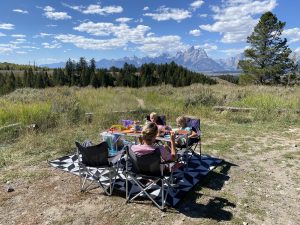 But we also took the time to relax a bit more in the amazing ‘forest camp’ where we spent the whole week. This was the first real ‘National Forest dispersed camping’ area on our trip (a lot more would follow). These areas in nature (forest, desert, etc.) on ‘public land’, can be used by all US citizens and visitors for free camping. There is usually a 7 or 14 day limit to use them, there are no or limited facilities so it’s ‘pack it in/pack it out’ all the way. The National Forest camps are often found close to the National Parks where wild camping is strictly forbidden and official campgrounds are often booked months in advance. As such they offer a good ‘overflow’ solution. We were amazed how disciplined people were about taking care of these lands. Hardly a piece of thrash to be found.
But we also took the time to relax a bit more in the amazing ‘forest camp’ where we spent the whole week. This was the first real ‘National Forest dispersed camping’ area on our trip (a lot more would follow). These areas in nature (forest, desert, etc.) on ‘public land’, can be used by all US citizens and visitors for free camping. There is usually a 7 or 14 day limit to use them, there are no or limited facilities so it’s ‘pack it in/pack it out’ all the way. The National Forest camps are often found close to the National Parks where wild camping is strictly forbidden and official campgrounds are often booked months in advance. As such they offer a good ‘overflow’ solution. We were amazed how disciplined people were about taking care of these lands. Hardly a piece of thrash to be found.
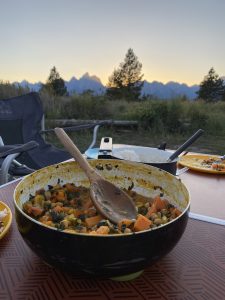 This particular site was in high demand so when we were able to get one of the prime spots, we stayed there for a couple of days more to enjoy the incredible views on the Teton mountains.
This particular site was in high demand so when we were able to get one of the prime spots, we stayed there for a couple of days more to enjoy the incredible views on the Teton mountains.
But eventually our water tank was getting empty (and toilet full) so we had to get moving again. Also we still had a trip planned over the Bear tooth highway and pass, which would close for winter as soon as the first big snows came. The last week the weather had been very nice but at the horizon of our 7 day weather forecast a ‘cold front’ was becoming visible. Time to go back north and explore part two of Yellowstone!

Beestachtig mooi!
wat een beestachtige natuur !